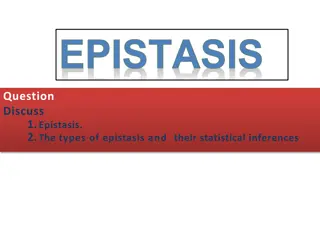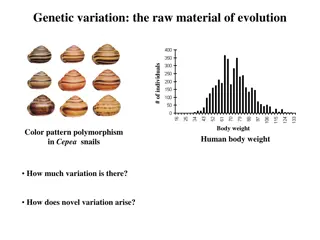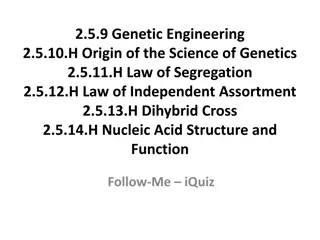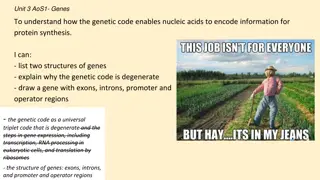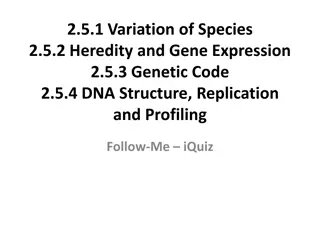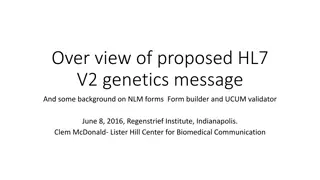Understanding Epistasis: Genetic Interactions and Their Implications
Epistasis is a phenomenon where the phenotypic expression of one gene is influenced by interactions with another gene. This concept, first introduced in 1909, plays a crucial role in genetics, affecting various traits and evolutionary processes. The difference between dominance and epistasis lies in the type of gene interaction involved. Chemical interpretation of genes and their products sheds light on how environmental factors can influence genetic outcomes. Various kinds of epistatic interactions like dominant epistasis, recessive epistasis, and duplicate gene effects demonstrate the complexity of genetic inheritance patterns. Understanding these interactions is essential for unraveling the mysteries of genetic diversity and trait expression.
Download Presentation

Please find below an Image/Link to download the presentation.
The content on the website is provided AS IS for your information and personal use only. It may not be sold, licensed, or shared on other websites without obtaining consent from the author. Download presentation by click this link. If you encounter any issues during the download, it is possible that the publisher has removed the file from their server.
E N D
Presentation Transcript
Introduction Chemical Interpretation Kinds of Epistasis Dominant Epistasis. Recessive epistasis ( ) (ii) (iii) Duplicate Recessive Genes (iv) Duplicate Dominant Genes (v) Duplicate Genes with Cumulative Effect (vi) Dominant Recessive Interaction References
Epistasis is Greek word meaning standing over. It was first used in 1909 by Bateson to describe a masking effect. An interaction between a pair of loci, in which the phenotypic effect of one locus depends on the genotype at the second locus. Genes whose phenotype are Expressed-epistatic altered or suppressed-hypostatic
Difference between dominance and epistasis Dominance Epistasis Involves intra-allelic gene interaction. Involves inter-allelic gene interaction. One allele hides the effect of other allele at the same gene pair. One gene hides the effect of other gene at different gene loci.
Chemical interpretation: A gene is a chemical determiner. Gene products interact with the environment and factors such as temperature, light, hormones and enzymes. If intermediates, it can lead to another phenotype and hence disturb the Mendelian ratios. there is any problem or mutation in the
Example that function in eye Effects pigmentation in Drosophila. of two genes The genes are vermilion (v) and cinnabar (cn). Flies that are mutant for cn lack xanthommatin. They have bright red eyes because of the drosopterin. Mutant v flies also lack xanthommatin but for a different reason. In these flies the pathway is blocked because there is no functional V enzyme.
Kinds of Epistatic Interactions In epistasis less than four phenotypes appear in F2. ( ) Dominant Epistasis. (12:3:1) (ii) Recessive epistasis.(9:3:4)(Supplementary interaction) (iii) Duplicate Recessive Genes (9:7) (Complementary Genes) (iv) Duplicate Dominant Genes. (15:1) (v) Duplicate Genes with Cumulative Effect (9:6:1) (vi) Dominant Recessive Interaction (13:3)
Dominant Epistasis. (12:3:1) Dominant allele (eg.,A) of one gene hides the effect ofallele of another gene (eg., B) and expresses itselfphenotypically. The B allele (hypostatic) will be expressed only when gene locus A contains two recessive (aa)alleles. Thus, the genotypeAABB orAa Bb andAAbb or Aabb produce the same phenotype genotype aa BB or aa Bb and aa bb produce twoadditional phenotype. This type of dominant epistasis modifies the classical ratioof 9:3:3:1 into 12:3:1
Epistatic Hypostatic Phenotypic alleles alleles Expression aa bb b aa BB, Bb B AA, Aa Bb, Bb, bb A
Example: Studied in summer squash (Cucurbita pepo) Common fruit colors-white,yellow &green White (W) is dominant over colored squash Yellow (Y) is dominant over green squash Pure breeding white fruited variety is crossed with the double recessive green variety,F1 hybrids are all white When the hybrids are selfed-white, yellow &green fruited plants arise in the ratio of 12:3:1
The effect of dominant gene Y is masked bythe dominant gene W (epistatic gene) WY Wy wY wy / P WWYY X wwyy (white) F1 (white) (selfed) F2 White:Yellow:Green 12 : 3 : 1 WY WWY Y WWY y WwY Y WwYy WWY y WWyy WwYy WwY Y Ww Yy Wwy y wwY y wwy y (green) WwYy Wy wY WwYy wwYY wy Wwyy wwYy
Recessive epistasis. (9:3:4) (Supplementary interaction) Recessive allele (aa) of one gene locus hides the effect of another gene locus (BB, Bb or bb) and expresses itself phenotypically. The alleles of B locus express themselves only when epistatic locus has dominant alleles (eg.,AA orAa). This will modify the ratio 9:3:3:1 to ratio 9:3:4
Epistatic Hypostatic Phenotypic alleles alleles Expression aa BB, Bb, bb a AA,Aa BB, Bb B AA,Aa bb b
In horses, brown coat color (B) is dominant over tan (b). However, how that gene is expressed in the phenotype is dependent on a second gene that controls the deposition of pigment in hair. The dominant gene (C) codes for the presence of pigment in hair, whereas the recessive gene (c) codes for the absence of pigment.
Duplicate Recessive Genes (9:7) (Complementary Genes) Both the genes loci have homozygous recessive alleles and both of them phenotype. produce identical Both dominant alleles are necessary to produce a different phenotype. e.g.: AABB, AaBB, AaBb, in all these combinations. Both the dominant alleles (A and B) are present and they will produce a different phenotype. Whereas aaBB or bbAA, in which the other dominant allele is absent, produces the normal phenotype.
Epistatic Hypostatic Phenotypic alleles alleles Expression aa BB, Bb, bb No phenotype production AA, Aa,aa bb AA,Aa BB, Bb Phenotype due to dominant
Bateson and Punnett observed that when two white flowered varieties of sweet pea, Lathyrus odoratus were crossed, F1progeny had coloured When F1was selfed, the F2ratio showed presence of both coloured and white flowered varieties in the ratio 9:7. flowers. the In man, deaf mutism is complementary gene dependent, depending upon two dominant genes A and B, the presence of both of them is responsible for normal hearing and speech.
In this case dominant alleles on both locus are required hence wherever A and Bboth are present they result into purple effect masking the white. This is because A and B alleles modifiedthe colorless precursor by showing their effects
The purple pigment in corn requires that two enzymes (controlled by two dominant alleles) must be active for the pigment to form. Two white varieties of corn showing the genotypes AAbb and aaBB, will produce a ratio of 9/16 purple and 7/16 white ears, depending upon the nine different possible arrangements chromosomes (and characteristics. of the alleles) for these
Duplicate Dominant Genes. (15:1) The dominant alleles of both the genes produce the same phenotypic effect giving the ratio 15:1. At least one of the dominant allele is necessary for the phenotypic effect. e.g. AABB, AaBb, Aabb, aaBB, aaBbgive one phenotype. In the absence of all the dominant genes (only in case of aabb), the recessive phenotype will be expressed. The duplicate genes are also called pseudoalleles
Epistatic Hypostatic Phenotypic alleles alleles expression Another aa bb phenotype Same aa BB, Bb phenotype AA,Aa bb AA,Aa Bb, Bb
As observed by G.H.Shull, the seed capsules of Shepherd s purse (genus Capsella) occur in different shapes, two i.e. triangular and top shaped. When generation showed plants with triangular and top shaped capsules in the ratio 15:1 F1 individuals were self crossed, the F2 (A and B) would produce plants with triangular-shaped capsules. aabb would produce plants with top shaped capsules.F2 phenotypic ratio 15(triangular) 1(Top shaped).
AABB (triangular) aabb P : (top-shaped) AaBb (triangular) F1: AB Ab aB ab AaBb AABb (triangular) AaBB (triangular) AABB (triangular) AB (triangular) Aabb AAbb AaBb AABb Ab (triangular) (triangular) (triangular) (triangular) aaBb AaBb aaBB AaBB aB (triangular) (triangular) (triangular) (triangular) aabb Aabb aaBb AaBb Ab (triangular) (triangular) (triangular) (top-shape)
Duplicate Genes with Cumulative Effect. (9:6:1) Both the dominant non allelic alleles, when present together, give a new phenotype, but when allowed to express independently, phenotypic expression separately. they give their own In the absence of any dominant allele, the recessive allele is expressed.
Epistatic Hypostatic Phenotypic alleles alleles expression aa bb Neither a nor b aa BB, Bb B only AA,Aa bb Aonly AA,Aa Bb, Bb A+B mutually supplement
In pigs S and s are allelic genes; S giving sandy colour ss giving white colour. A non-allelic gene R also gives sandy colour (same as S) but when both the dominant genes interact together, they give red colour. Non-allelic gene does not interact with ss
P : SSrr (sand ssRR (sandy) SsRr (red) F1: SR sR sr Sr SsRr SSRR SsRR (red) SSRr (red) SR F : 2 (red) (red) SsRr Ssrr SSrr SSRr Sr (red) (sandy) (sandy) (red) ssRR ssRr SsRr SsRR sR (sandy) (sandy) (red) (red) SsRr ssRr ssrr Ssrr Sr (red) (sandy) (white) (sandy)
Dominant Recessive Interaction (13:3) The heterozygous condition, of one gene and the homozygous recessive allele (bb) of other gene produces the same phenotype. dominant allele (A), either in homozygous or In F2generation, progenies having A (homozygous or heterozygous) or bb (homozygous) will not allow the C gene to be expressed. Genotype AABB, AABb, AaBb and Aabb produce same phenotype and the genotype aaBB, aaBb and aabb produce another but same phenotype.
Epistatic Hypostatic Phenotypic alleles alleles expression aa Bb, BB, bb a doesn t inhabit B or b AA, Aa Bb, Bb , bb A inhibit B orb
In Leghorn fowl, the white colour of feather is formed by CCII (due to the presence of epistatic gene I). Similarly in Plymouth Rock fowl the white colour of feather is formed by ccii (due to the absence of dominant C gene). Therefore C is suppressed by inhibitor gene both in dominant (I) and recessive (ii) condition.
CCII ccii P: (White Leghorn) (White Plymouth Rock) CcIi (white) F1: Ci cI ci CI CcIi CCII CCIi (white) CcII (white) CI (white) (white) CCii CcIi Ccii CCIi (white) Ci (colored) (white) (colored) CcII CcIi ccII ccIi cI (white) (white) (white) (white) CcIi Ccii ccIi ccii ci (white) (colored) (white) (white)
Example: Interaction involves an inhibitory factor which by itself has no phenotypiceffect But, when present in the dominant form prevents or inhibits the expression of another dominantgene eg :.Malvidin in primula flowers Malvidin is a O-Methylated responsible for the blue pigments in Primula polyanthus plant anthocyanin
Synthesis of malvidin (blue) is controlled by gene K In recessive state(k), malvidin is not synthesized Production is suppressed by gene D, found at completely different locus D allele is dominant to K allele
KKdd (blue) x kkDD (white) KkDd (selfed) (white) KD Kd kD kd / KD KKD D KKD d KkD D KkDd Kd KKD d KkD D KkDd KKdd KkDd Kkdd kD KkDd kkDD kkDd kd Kkdd kkDd kkdd
KkDd genotype will not produce malvidin dueto the presence of Dallele Thus, white & bluecolored flowers producing plants are obtained in the ratioof 13:3 Also known as dominant
References: Hartl,D.L., & Jones,W.E., (1998) Genetics Principles and Analysis ed: 4thJones and Bartlett Publishers International London,UK, pp: 19,20,61-63 Miko, phenotype effects. Nature Education 1(1) I., (2008) Epistasis: Gene interaction and Richards,J.E. & Hawley, R. S., (2010) The human genome ed: 3rdAcademic Press, pp: 31 Verma,P.S., & Agarwal,V.K., Genetics, Molecular Biology, Evolution and Ecology ed: 24thS.Chand and Company Ltd,Ram Delhi. Pp: 45-56 (2004) Cell biology, Nagar, New




